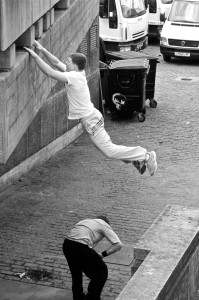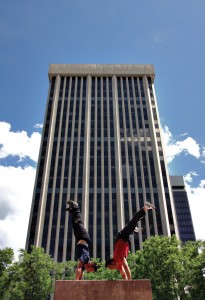 A SPORT THAT IS NON-COMPETITIVE IS HARDLY APPEALING TO ANYONE, RIGHT? WRONG. SAIRAM NATARAJAN INTRODUCES YOU TO PARKOUR, A SPORT THAT IS BOTH VISUALLY APPEALING AND PHYSICALLY CHALLENGING, AND IS FAST GRABBING SOME SERIOUS EYEBALLS
A SPORT THAT IS NON-COMPETITIVE IS HARDLY APPEALING TO ANYONE, RIGHT? WRONG. SAIRAM NATARAJAN INTRODUCES YOU TO PARKOUR, A SPORT THAT IS BOTH VISUALLY APPEALING AND PHYSICALLY CHALLENGING, AND IS FAST GRABBING SOME SERIOUS EYEBALLS
Remember James Bond in Casino Royale? Bond chases a bomb-maker on foot through an under-construction building. The irony of the scene is that Bond looks clumsy and inept in his run while the bomb maker (who according to the script must get caught by Bond) is almost lyrical in his run as he negotiates and sometimes uses to his advantage every obstacle he runs into. THAT, for the uninitiated is Parkour 101 by one of the legends of this sport, Sébastien Foucan!
WHAT IS PARKOUR?
Parkour derives its name from the French parcours du combattant, a form of military training involving negotiating obstacles. The sport, pursued and promoted by David Belle and his father Raymond Belle, was christened Le parcours. It encompasses climbing, jumping, running, balancing; it is basically a holistic sport that pushes the traceur, the name used for parkour practitioners, to get from point A to B in the fastest, most efficient manner, using their bodies and surroundings in a safe manner.
THE BIRTH OF THE SPORT
Parkour’s forerunner and French naval officer Georges Hébert, inspired by African tribesmen during WW1, used ten fundamental activities – walking, running, jumping, quadrupedal movement, climbing, balancing, throwing, lifting, self-defense and swimming – as a physical training instructor. During WW1 and WW2, Hébert’s teaching became standard in French military training and then many countries’ militaries followed suit.
Obstacle training was being pursued outside the military as well. David Belle, his cousins and friends started training as a group after being inspired by Raymond, David’s father. In the 90s, this group started receiving television coverage. It now has a great bit of following with a greater amount of curiosity, with people enrolling for obstacle courses to improve their endurance, and confidence courses.
 PARKOUR IN INDIA
PARKOUR IN INDIA
Parkour in India is gaining slow but steady popularity. Metro cities like Delhi, Mumbai and Bangalore are seeing a lot of parkour groups that usually train together. Jaipur, Cochin and Ludhiana have also seen some interesting activity around this sport. Movies, both international and Indian, are also using parkour techniques quite freely, and that is also helping the sport gain popularity. Obstacle races such as the XWarrior Race and Devil’s Circuit are becoming very popular and competitive and more and more people are taking up parkour to train for these races.
PARKOUR HOTSPOTS
Any place for safe training and practice without much outside interference is called a hotspot. While any park, unattended ruins, beaches and under-construction buildings could be the usual hotspots, only Parkour Mumbai has gone to the extent of actually identifying some and rating them on difficulty levels. Kamla Raheja Park/Aeroplane Park in Santa Cruz and Hiranandani in Powai are some of the tougher hotspots while Gulmohar Garden in Andheri is a good place for beginners. In Delhi, Parkour groups have been seen practising in metro stations, college campuses and near some forts.
PARKOUR TRAINING
Training for parkour should be as serious as the sport itself. Parkour is not a set of moves or tricks; base techniques are used regularly and changed to suit a particular situation or environment. It is physically demanding and should be practiced only within the limits of your physical condition and ability; which can be improved with training. One should look to condition the body by training with body weight using exercises such as squats, push-ups, pull-ups and leg-lifts. Running is also an essential part and thus one should look to run close to 12-16 km a week, with a lot of sprinting thrown in. Strengthening is also essential and thus lifting weights cannot be overlooked. As diet is an indispensable part of any training regimen, one should look to eat healthy with lot of lean proteins and minimal carbs or fat. Processed food is a big no! Water should be consumed in abundance.
IN CONCLUSION
Parkour is an adrenalinegushing sport which will make your jaw drop if you are bystander. If you choose to take the plunge and train, make sure you condition your body well. Always train in spots which are safe and where the chances of getting hurt are lower. It is advisable to have an expert to guide while you train. Happy training!
SOME PARKOUR TERMINOLOGY
1. Traceur/Traceuse: A practitioner of parkour (male/female)
2. Jam: A gathering of practitioners brought together to train and socialise
3. Training: Practicing parkour. A traceur doesn’t ‘do’ parkour, he/she trains it
4. Conditioning: The practice of strengthening your body for the stresses of parkour.
5. Bail: Failing a jump or move
6. Spot/Hotspot: A place to train. Good hotspots will have a lot of walls, places to jump, low obstacles to vault, railings, etc
PARKOUR PRACTITIONERS
DAVID BELLE
Founder of parkour; has been in various films and documentaries
Signature move: Handstand
CHASE ARMITAGE
A Wu-Xu expert; at 22 he is one of the most popular traceurs
Signature move: Loserwall flip
SÉBASTIEN FOUCAN
Father of freerunning
Signature move: Huge jumps
DANIEL ILABACA
One of the best freerunners; the monkey gainer and palm flip were his creations
Signature move: Monkey gainer
SIMILAR SPORTS
FREERUNING
Fundamentally parkour but with more flips and jumps
BUILDERING
The act of climbing on the outside of buildings and other artificial structures
TRICKING
An aesthetic blend of flips, kicks, and twists incorporating techniques from various martial arts, gymnastics, break dancing and similar disciplines
POWERBOCKING
Jumping and running with elastic-like spring-loaded stilts
PARKOUR GROUPS IN INDIA
* Parkour in India, Mumbai and Delhi
* Parkour Mumbai, Mumbai
* ChennaiParkour, Chennai
* Pace, New Delhi
BASIC PARKOUR TECHNIQUES
QUADRUPEDAL MOVEMENT: Moving on all four limbs with the back and shin parallel to the ground and hands shoulder-width apart. The knees should stay off the ground and the limbs should alternate while moving i.e. right leg moves with left hand.
RUNNING: For short, fast running bursts, one should run on the ball of their feet, with the heel not more than an inch off the ground.
GENERAL LANDINGS: While landing, it is essential that one lands on the ball of the feet to avoid damage to the joints. No heel, no toes and no flat feet! The knee should not be bent for more than 90 degrees unless the situation demands it.
BASIC BALANCE: Balance is purely a mental thing. If a rail is two inches off the ground most people could walk along it easily. Put that rail 10 feet in the air and suddenly it’s not so easy. One should lower the body to get better control. The closer the centre of gravity to the ground, the easier to balance.
ROLLING: Rolls can be used to absorb impact to avoid injuries to the joints and limbs. A good roll is one that allows you to roll on concrete painlessly and without damaging yourself.
CLIMBING: For going up and down obstacles. One should try to have three points of the body secure while climbing so that the fourth limb can help if any of the three slip.
PRECISION JUMP: To jump from one point to another, the feet must be together with the body weight on the balls of the feet. The arms should be behind to control direction. Lean forward, push with the legs with the whole body straight. In the middle of the leap, the knees should go inwards and then outwards to push the body ahead towards the landing point.
Volume 3 Issue 8




























